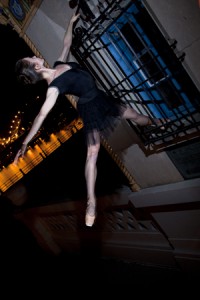by Emily Kate Long
I had the privilege last week of attending Dancer Health Day 2012, held July 9 at the National Museum of Dance in Saratoga Springs, New York. The event featured a panel of presenters who addressed a wide range of health issues for dancers: psychology, nutrition, foot health, injury rehab, and cross training, to name a few. The speakers present were Dr Linda Hamilton, Ph.D.; Eliza Minden, creator of Gaynor-Minden pointe shoes; Julia Erickson, co-owner/co-developer of Barre—a real food barre; Meghan Del Prete, a Pilates studio owner and Skidmore College dance faculty member; and Kim Teter, a physical therapist and former member of American Ballet Theatre. These women’s stories were spot on—they’ve been through all the struggles of a life in dance and are now focusing their talents to alleviate some of those difficulties for future generations of dancers.
Ms Minden’s presentation focused on foot and lower leg health as affected by pointe shoes—traditional paste shoes as well as the high-tech Gaynor-Mindens. A wealth of related information is available on the company’s website, dancer.com, and in Ms Minden’s latest book, The Ballet Companion.
Dr Hamilton’s talk was one of the highlights of the event. She spoke briefly about everything from sleeping habits to workplace stress to injury. She really projected compassion and encouragement—a sense of knowing how scary and confusing health maintenance can be, especially for young dancers. Her important message to the crowd of mostly middle- and high school-age girls was the importance of being aware of our habits so that we can monitor their effects and modify our behavior when necessary. Her latest book, The Dancer’s Way, provides concrete strategies for modification as well as screenings and worksheets for injuries, diet, and stress.
Julia, currently a principal dancer with Pittsburgh Ballet Theatre, spoke about her health experiments with candor and humor: her “bagel-bagel-pasta” diet in the 1990s, her current love of Pilates for cross training, and the “un-glamorous” way she had to scarf snacks on her five-minute breaks to survive rehearsals for her debut in Swan Lake. Those frantic snack breaks were what led to her to develop Barre, a whole-food bar marketed especially to dancers. More information about Barre is available on its website.
Ms Teter and Ms Del Prete both addressed cross training and rehabilitation for dancers for injury prevention and recovery. Both noted the importance of seeking help from medical and fitness professionals who are familiar with dancers’ unique physical training requirements.
Being at this forum was thrilling. The Museum plans to make Dancer Health Day an annual event, and I would love to see it implemented as a yearly occurrence at venues all over the country. This is such an important conversation to have now, as dance is struggling to redefine itself as a field and dancers seek to be seen at once as artists, athletes, and cultural and social ambassadors. Dance is a broad service, and the needs of its participants are likewise broad. The more active we can be in preserving and improving all aspects of our own wellness, the better off our art form will be. Here’s to our health!
BIO:

Contributor Emily Kate Long began her dance education in South Bend, Indiana, with Kimmary Williams and Jacob Rice and graduated in 2007 from Pittsburgh Ballet Theatre School’s Schenley Program. Ms Long attended Milwaukee Ballet School’s Summer Intensive on scholarship before being invited to join Milwaukee Ballet II in 2007. She also has spent summers studying at Saratoga Summer Dance Intensive, Miami City Ballet, Pittsburgh Ballet Theatre School, Pittsburgh Youth Ballet, and Ballet Chicago.
Ms Long has been a member of Ballet Quad Cities since 2009. She has danced featured roles in Deanna Carter’s Ash to Glass and Dracula, participated in the company’s 2010 tour to New York City, and most recently performed the title role in Courtney Lyon’s Cinderella and the role of Clara in The Nutcracker. Prior to joining Ballet Quad Cities Ms Long performed with Milwaukee Ballet and MBII in Michael Pink’s The Nutcracker and Candide Overture, Petipa’s The Sleeping Beauty and La Bayadére, Balanchine’s Who Cares?, Bournonville’s Flower Festival in Genzano and Napoli, and original contemporary and neoclassical works by Tom Teague, Denis Malinkine, Rolando Yanes, and Petr Zaharadnicek.





